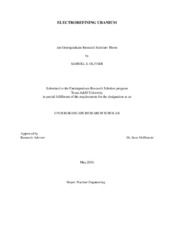| dc.description.abstract | The Fuel Cycle and Materials Laboratory at Texas A&M University needs a method of removing impurities from depleted uranium samples. A non-aqueous, lab-scale electrorefiner will be constructed to solve this problem. The electrorefiner will employ electrolysis to electrochemically separate the uranium from the impurities in the samples. Electrorefining has been applied to reprocessing spent nuclear fuel and is an effective way to close the nuclear fuel cycle. Los Alamos National Laboratory, Argonne National Laboratory and Idaho National Laboratory have conducted extensive research on electrorefining spent nuclear fuel. This report contains a discussion on the importance and theoretical background of electrorefining, a literature review of previous work conducted by Los Alamos National Laboratory, Argonne National Laboratory and Idaho National Laboratory and the design of the lab-scale electrorefiner to be built at the Fuel Cycle and Materials Laboratory. | en |


